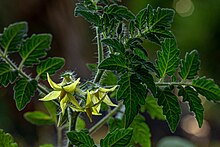| Solanum pimpinellifolium | |
|---|---|

| |
| Scientific classification | |
| Kingdom: | Plantae |
| Clade: | Tracheophytes |
| Clade: | Angiosperms |
| Clade: | Eudicots |
| Clade: | Asterids |
| Order: | Solanales |
| Family: | Solanaceae |
| Genus: | Solanum |
| Species: | S. pimpinellifolium
|
| Binomial name | |
| Solanum pimpinellifolium | |
| Synonyms[2] | |
|
Lycopersicon pimpinellifolium (L.) Mill. | |
Solanum pimpinellifolium, commonly known as the currant tomato[3] or pimp,[4] is a wild species of tomato[5] native to Ecuador and Peru but naturalized elsewhere, such as the Galápagos Islands. Its small fruits are edible, and it is commonly grown in gardens as an heirloom tomato,[6] although it is considered to be wild[7] rather than domesticated as is the commonly cultivated tomato species Solanum lycopersicum. Its genome was sequenced in 2012.[8]

- ^ "Species Solanum pimpinellifolium (Currant tomato) (Lycopersicon pimpinellifolium)". Uniprot Taxonomy. Retrieved January 28, 2011.
- ^ "Solanum pimpinellifolium". Germplasm Resources Information Network. Agricultural Research Service, United States Department of Agriculture. Retrieved 2010-01-12.
- ^ USDA, NRCS (n.d.). "Solanum pimpinellifolium". The PLANTS Database (plants.usda.gov). Greensboro, North Carolina: National Plant Data Team. Retrieved 17 November 2015.
- ^ Cite error: The named reference
smithwas invoked but never defined (see the help page). - ^ "New nomenclature for lycopersicon". Sol Genomics. Retrieved February 17, 2013., from Spooner, D.M.; Peralta, I.E.; Knapp, S. "AFLP phylogeny of wild tomatoes [Solanum L. section Lycopersicon (Mill.) Wettst. subsection Lycopersicon ]". Taxon.
- ^ "Smallest Tomato: The Currant Tomato and other Small Wonders". Tomato Casual. Archived from the original on June 11, 2017. Retrieved February 18, 2013.
- ^ Bai, Y.; Lindhout, P. (2007). "Domestication and breeding of tomatoes: what have we gained and what can we gain in the future?". Annals of Botany. 100 (5): 1085–1094. doi:10.1093/aob/mcm150. PMC 2759208. PMID 17717024.
- ^ The Tomato Genome Consortium (31 May 2012). "The tomato genome sequence provides insights into fleshy fruit evolution". Nature. 485 (7400): 635–641. Bibcode:2012Natur.485..635T. doi:10.1038/nature11119. PMC 3378239. PMID 22660326.